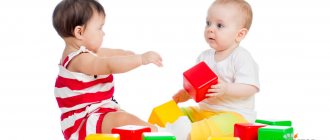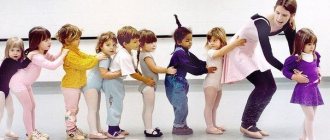Article “Labor education of young children”
In early age groups, children's work is organized in the form of individual assignments. Kids are little interested in the result; they are attracted by the process of action itself. And so they work together with the teacher: they help set the table, lay out materials for classes, water the plants, pick vegetables in the garden, etc. The adult takes on the most difficult work, leaving for the child what he can do. In the process of work, the teacher helps the child master the necessary skills, cope with emerging difficulties, and correct mistakes.
The purpose of labor education:
Contribute to the formation of a positive attitude towards work.
Types of work for young children:
Self-service
- this is the work of a child aimed at serving himself (dressing, undressing, eating, sanitary and hygienic procedures).
Household work
has a social orientation. This is the work of maintaining order in a room or area.
Labor in nature
– this is the work of caring for plants and animals, growing vegetables in the garden, landscaping the area, etc.
SELF-CARE.
1. To promote in children the ability to independently care for themselves (while undressing, dressing, washing, eating).
2. Encourage children, under the supervision of an adult, and then wash their hands independently when dirty and before eating, wipe their face and hands dry with a personal towel.
3. Contribute to the development of the ability to put oneself in order with the help of an adult.
4. To promote the development of the skill of using individual objects (handkerchief, napkin, towel, comb, pot).
5. Encourage children to be independent when eating, teach them to hold a spoon in their right hand.
6. Ensure the development of the ability to dress and undress in order.
7. Encourage the child to take off clothes and shoes (unfasten front buttons, Velcro fasteners) with a little help from an adult.
8. Ensure the development of the ability to carefully fold removed clothes in a certain order.
9. Encourage people to wear clothes and shoes correctly.
HOUSEHOLD WORK.
1. Contribute to the development of the ability to put toys and things in their place.
2. To promote the habit of maintaining cleanliness and order in the group.
3. To promote the development of the ability to correctly carry a chair and place it in the right place.
4. Provide familiarization with the work of adults (nanny, janitor, driver, nurse, cook).
5. Encourage you to carry out the teacher’s instructions, help adults: put garbage in the basket, lay out boards for modeling, arrange bread bins without bread, napkin holders, lay out spoons, etc.
WORK IN NATURE.
1. Involve children in watering flowers in the flowerbed under the guidance of a teacher.
2. Promote the desire to care for indoor plants.
3. Encourage feeding birds in winter.
4. Ensure the development of the ability to work with shovels, brooms, and rakes.
5. Create a desire to help the teacher plant onions,
in sowing large seeds (peas, beans, nasturtium), etc.
Emphasizing the role of labor education, K. D. Ushinsky wrote:
“The opportunity to work and love for it is the best inheritance that both the poor and the rich can leave to their children.” Labor education should be part of a child’s life from a very early age and carried out consistently and systematically.
MAGAZINE Preschooler.RF
Formation of initial labor skills in young childrenBalabanova Maria Gennadievna, teacher of the 1st qualification category of the municipal autonomous preschool educational institution "Kindergarten No. 24 of a combined type"
Self-care is the beginning of the labor education of a preschooler. The formation of self-care skills is of paramount importance for the mental development of the child as a whole. Mastering self-care skills (the ability to dress and undress, take care of yourself, use the toilet, eat independently, wash yourself, etc.) directly affects the child’s self-esteem and is an important step towards his independence.
Recently, more and more parents are overprotective of their children. Some parents often do everything for their children (clothing, feeding), believing that their child is still very small. This leads to the child not developing independence in self-care skills.
The initial prerequisites for the development of labor activity and labor education of children are laid at an early age.
Let's figure out where to start and how everything should happen to achieve the desired result. First, let’s answer the question: for young children include For a child of the third year of life, self-care includes mastering the following skills:
- eating (eating with a spoon, drinking from a cup)
- undressing and dressing (taking off and putting on shoes, panties, tights, shorts, trousers or skirt, hat, mittens)
- body hygiene (wash hands and face, dry them with a towel, use a handkerchief and napkin)
- neatness (use the potty).
At the same time, children begin to be involved in performing simple labor actions with similar results: bring some objects, put a plate of bread on the table, collect cubes from the floor into a box, etc.
Elementary labor actions present significant difficulties for children, and their development requires careful pedagogical guidance. We develop self-service skills based on the great interest of children of this age in independent actions with objects, and on greater imitation of the actions of an adult. all attempts to independently achieve results ( “I do it myself!” ). However, in order for a child to achieve a result, the baby must be taught to see it and taught the appropriate actions. This is done by adults both during self-service and in the process of household work, where the child is only a spectator, for example: they washed their hands - they became clean; wiped with a towel - they became dry and clean; We ironed the dolls' dresses - they became beautiful, ironed. The emotional reaction of an adult to achieving a result forms an emotionally positive attitude towards him and the child, awakens the desire to achieve it. An explanation from an adult once again allows you to connect the process of action with the result and goal: you washed your hands, they became clean - you can go to lunch.
As work actions are mastered, the teacher helps only with the most difficult ones for the child, and then simply prompts the next action that the child performs (first straighten the towel on your hands, then wipe your face, etc.). Every child's success must be celebrated. Encouragement creates a joyful mood in the child, a desire to repeat the action, to achieve the desired result.
To consolidate the initial labor actions, the following conditions are necessary:
a) demonstration, explanation and exercise;
b) consistency of requirements for children in kindergarten and in the family (children themselves perform feasible self-care activities);
c) constancy of requirements for the sequence of execution, quality of work actions and results;
d) a calm business environment that takes into account the child’s capabilities;
e) transition from individual learning to group learning as the actions are mastered and the ability to listen to an adult.
The independence of a child of this age in self-care is based on the development of the skills of buttoning, unfastening, lacing, etc. To develop such skills, play exercises are used (dressing dolls, when children repeatedly button or unfasten their clothes) and specially made teaching aids - different types of fasteners. Children willingly practice quite complex movements and master the necessary skills. I take a creative approach to using folklore as an emotional and figurative means of influencing children. This causes children joy, pleasure, and a desire to learn skills on their own.
In order to consolidate the sequence of labor actions for self-care (dressing, undressing, washing, etc.), organized educational activities are carried out using game techniques: put the doll to sleep, dress the doll for a walk, wash the doll, etc.
All this ensures not only learning, but also habituation, that is, nurturing the habit of acting in certain conditions in a learned way. A small child develops habits quickly and quickly fades away. Therefore, it is necessary to constantly repeat labor actions, taking into account the capabilities of the growing child. Thus, the methodology of labor education provides for the formation of labor actions in young children, their focus on results and the desire to overcome feasible difficulties in the process of achieving results.
Any action can be divided into small subactions performed in a certain order. When teaching your child a new skill, create an algorithm and act according to it each time. An example of putting on panties might look like this:
Sit on the chair
Take the waistband of your pants with both hands
Lift one leg and put it in one pant leg
Put your foot on the floor
Lift the other leg and put it in the other pant leg
Stand up and pull your pants up with both hands
For each subaction, you can draw schematic mnemonic tables that can be shown to the baby while performing the action to make it easier to remember the sequence of its implementation.
Remember that the speed of formation of self-care skills depends on the individual characteristics of the child, the type of nervous system (choleric, phlegmatic, sanguine and melancholic), on the speed of memorization, on the family attitude towards cleanliness and tidiness, since it is the example of parents and loved ones that is the main thing for the baby.
Don’t forget to give a positive assessment to your child’s actions! Any praise has a positive effect on achieving a good result. This could be a kind word or touch, small homemade gifts (made of paper, thread, salt dough or plasticine, crafts made from natural materials), and sometimes a sweet treat. Use different ways to tell your child that he is doing well: “Very good! Well done! Great! You did it! Hooray! Amazing! You did it! Great! Right! I am so glad!"
| Next > |
The purpose and objectives of labor education of preschool children.
Page 1 of 4Next ⇒
MDK.02.02. Theoretical and methodological foundations for organizing the work activities of preschool children
Theoretical questions:
1. Theoretical foundations of labor education of preschool children.
2. The uniqueness of the work activities of children of early and preschool age.
3. Contents and methods of self-care management in different age groups.
4. Contents and methods of managing work in nature in different age groups.
5. Contents and methods of managing household work in different age groups.
6. Contents and methods of manual labor management in different age groups.
7. Content and originality of the use of instructions in different age groups.
8. The content and originality of the use of duty in working with children of different age groups.
9. Content and originality of collective work in different age groups.
10. Planning the work activities of children in a preschool educational organization.
11. Conditions for organizing labor activities in preschool educational institutions.
12. The use of artistic means of labor education in different age groups.
Answers:
Theoretical foundations of labor education of preschool children
Labor is a purposeful human activity aimed at modifying and adapting natural objects to satisfy one’s needs.
Labor education is a purposeful process of developing a willingness to work and a positive attitude towards work in the younger generation.
LABOR EDUCATION of preschoolers is a purposeful process of developing in children a positive attitude towards work, the desire and ability to work, morally valuable qualities, and respect for the work of adults.
Labor education is closely related to:
1. Moral education: Formation of moral and volitional qualities - perseverance, responsibility, conscientiousness; formation of positive relationships between children - mutual assistance, support, ability to negotiate.
2. Physical education: muscle development, arbitrariness, coordination, accuracy of movements.
3. Economic education: the formation of a caring attitude towards nature, the results of human activity, the understanding that work is paid.
4. Mental education: Satisfies the need for communication, develops thinking, requires attention and memory.
5. Aesthetic education: through teaching children to order, creating beautiful things, getting to know the creative professions of people.
Thus, labor education in unity with all other aspects of education ensures the comprehensive development of the younger generation.
The purpose and objectives of labor education of preschool children.
The goal of the entire system of labor education is the moral, psychological and practical preparation of children for conscientious work for the common benefit and the formation of the principles of hard work. In kindergarten, this goal is achieved in accordance with the age capabilities of the children, as well as the characteristics of their work activities.
Different researchers formulated the tasks of labor education
The classification of Yu.K. Babansky and V.I. Loginova is based on two groups of problems:
— Assisting the child in mastering work activity (in mastering the structure of activity, acquiring work skills and abilities);
— Development of the child’s personality (development of personality traits and qualities, formation of relationships).
In more detail, the tasks of labor education were divided into five groups by Valentina Gennadievna Nechaeva:
— tasks of instilling a positive attitude towards work in adults
(these tasks are carried out in all age groups of the kindergarten, since on this basis children form ideas about the need for work in life and its social character);
— tasks aimed at developing labor skills and their further improvement
(covering one hundred, at a younger age children learn only to perform a sequence of actions, at an older age the requirements for quality, pace of execution, and the ability to show ingenuity increase);
- tasks aimed at developing certain personal qualities in children
(work habit, responsibility, caring, thrift);
— tasks of developing personal and general work skills
(the ability to prepare attributes in advance, clean the workplace after work, plan your activities);
— tasks of forming a positive relationship between children in the labor process
(the ability to negotiate, work amicably, in concert, help each other, evaluate favorably).
Modern authors have identified the purpose of labor education and its tasks: (L.V. Kutsakova).
1Next ⇒
Recommended pages:
Use the site search:








